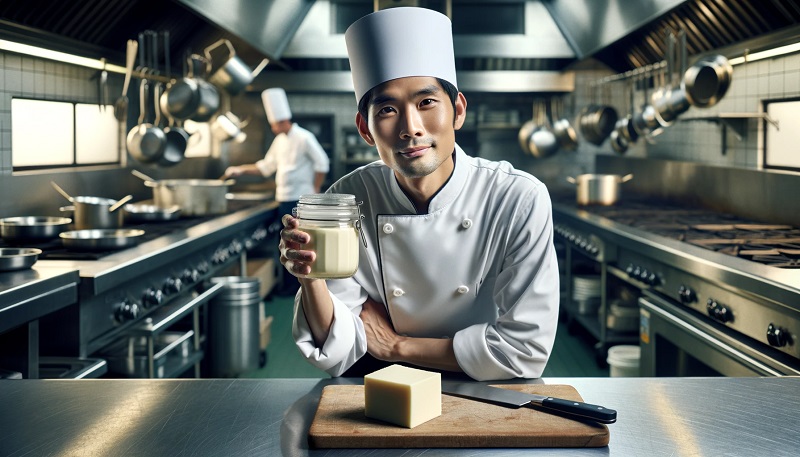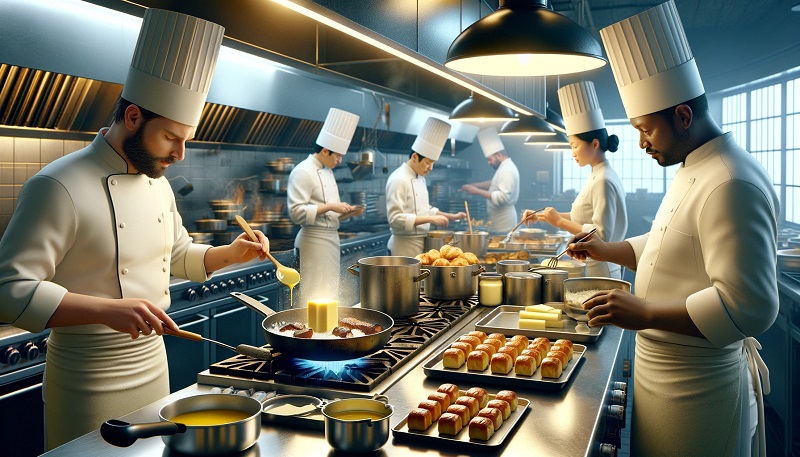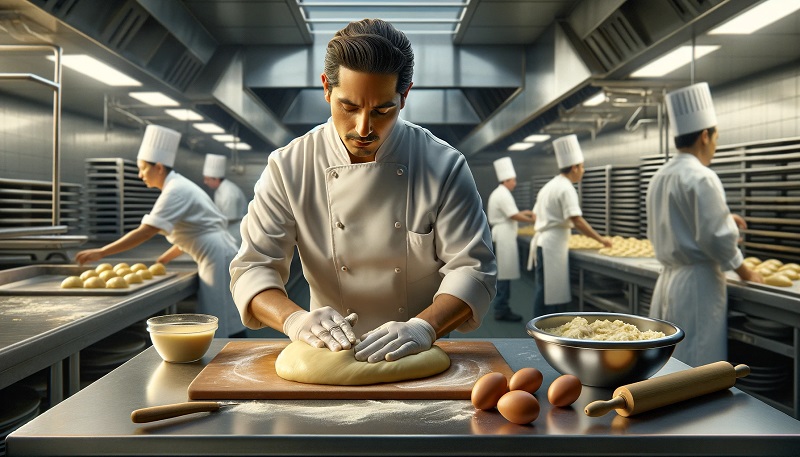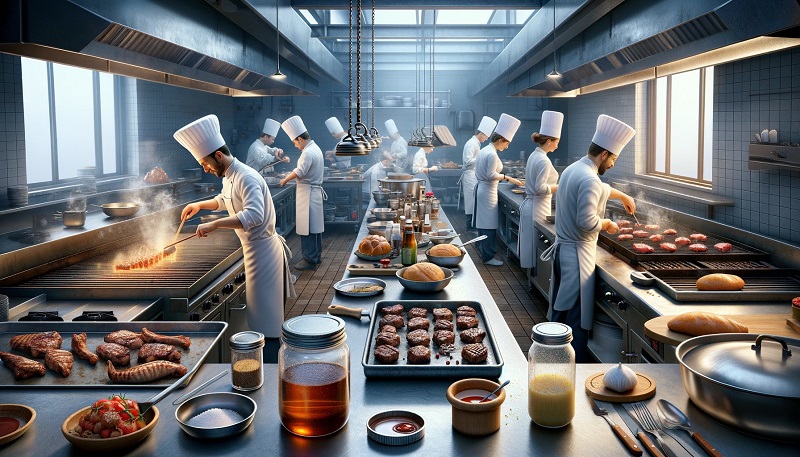🔥 Popular Free Downloads

THE FULL WORKS
All of our staff training manuals in one handy download!

FREE STAFF HANDBOOK
A totally customisable free staff handbook download.

FREE PROFIT & LOSS CALCULATOR
Keep on top of your expenses with our free profit and loss calculator.
⭐ Popular Resources

SWOT ANALYSIS
SWOT Analysis explained in detail accompanied by a free download.

DOWNLOADS HUB
The place to download all of our free forms, templates & guides.

FREE CASH FLOW CALCULATOR
Download our free template or use our online cash flow calculator.

BAR MANAGEMENT TRAINING
Simple and free online bar and cellar management training.
🔥 Popular Pages
- How to Run a Restaurant
- Awesome Articles
- Managing Your Staff
- Marketing Your Restaurant
- Restaurant Financing and Funding
- Maintaining Neutrality in Pronoun Usage
- Everything You Wanted To Know About Gin
- Safe Cooking Temperatures For Meat

The Rising Popularity Of Beef Tallow In Restaurants
Written by The Restaurant Doctor UK Team
Last Updated: 5th November 2023
In an era where gastronomy is returning to its roots, beef tallow is being rediscovered and revered by chefs. This age-old ingredient, with its deep-rooted history, is making a comeback, especially in upscale restaurants and gourmet kitchens. This guide aims to educate those in the trade about the intricacies of beef tallow and its profound impact on modern culinary arts.
What Is Beef Tallow?
Beef tallow, a cornerstone of traditional cooking, is the rendered fat primarily sourced from the suet of cattle. The term "rendering" in this context refers to the meticulous process of melting down the raw fat tissues. This process is typically done over a low, steady heat to ensure the preservation of the fat's integrity while effectively separating it from connective tissues, meat particles, and any potential impurities.
Transforming Fat into Tallow
As the fat melts, it transitions from a solid, often gristly mass into a clear liquid. Once cooled, this liquid solidifies into a creamy white or pale-yellow substance, which we recognise as beef tallow. Its consistency is like that of room-temperature butter but with a more granular texture.
Unique Fatty Acid Profile
One of the defining characteristics of beef tallow is its distinct fatty acid profile. It is rich in saturated fats, predominantly stearic and palmitic acids. These saturated fats not only contribute to its stability when exposed to high temperatures but also play a pivotal role in its flavour profile and mouthfeel.
Additionally, the presence of these acids ensures that beef tallow remains solid at room temperature, unlike many vegetable oils. This stability, combined with its unique melting point, positions beef tallow as a preferred fat in various applications, from frying to pastry-making.
Uses of Beef Tallow
Beef tallow, with its rich history in global cuisines, offers an array of applications in the professional kitchen, due to its impressive high smoke point of around 205°C (400°F). This high smoke point indicates the temperature at which the fat starts to break down and smoke, making beef tallow an exceptional choice for various high-heat cooking methods.

Deep Frying
One of the most celebrated uses of beef tallow is in deep frying. Its high smoke point ensures that the tallow remains stable during the frying process, resulting in foods that are crispy on the outside and tender inside.
Additionally, tallow's unique molecular structure means that it doesn't penetrate foods as heavily as some other oils, ensuring a less greasy end product. From fries to fritters, beef tallow enhances the crunch factor in deep-fried delicacies.
Searing
For dishes where a golden crust is crucial, beef tallow is the fat of choice. When searing meats or even vegetables, tallow facilitates an impeccable Maillard reaction, the chemical reaction responsible for the delightful browned and flavourful crust on seared foods. Its stability ensures that it won't break down quickly, allowing for a uniform sear.
Baking
Surprisingly, beef tallow also finds its place in the world of baking. When incorporated into doughs and batters, it can offer a distinct richness and flakiness, especially in pastries and pie crusts. Its natural flavour also adds a depth to baked goods that's hard to achieve with common fats like butter or shortening.
Roasting
Beef tallow can be brushed or drizzled over vegetables and meats before roasting. This not only aids in caramelisation but also imparts a subtle meaty flavour, elevating the overall taste profile of the roasted dish.
Sauces and Gravies
Due to its full-bodied flavour, beef tallow can be used as a base for various sauces and gravies, providing them with a velvety texture and deep richness.
Spreads
In some traditions, beef tallow, seasoned with herbs and spices, is used as a spread, much like butter. This can be served with rustic breads or used to flavour dishes.
Confit
The confit cooking method, where meat is slowly cooked in its own fat, can be wonderfully executed using beef tallow. This method preserves the meat while imbuing it with the rich flavours of the tallow.
The versatility of beef tallow extends beyond the common uses, and its rediscovery in contemporary circles is a testament to its multifaceted applications in creating gourmet dishes.
Flavour and Texture Enhancement
The allure of beef tallow in the culinary realm can be attributed to both its flavour-enhancing properties and the exceptional texture it lends to dishes.

Deep, Meaty Umami
At the heart of beef tallow's flavour profile is a pronounced meaty umami, a taste sensation often described as the fifth basic taste after sweet, salty, sour, and bitter.
Umami, a Japanese term translating roughly to "pleasant savoury taste," is evocative of broths and cooked meats.
Beef tallow, with its origins in beef fat, naturally brings this depth of flavour, making it a cherished ingredient in dishes where a rich, meaty undertone is desired.
Molecular Interaction with Ingredients
The unique molecular composition of beef tallow, rich in saturated fats like stearic and palmitic acids, interacts distinctively with other ingredients. This interaction is markedly different from plant-based fats, which have a different fatty acid profile.
For instance, when used in sautéing or frying, beef tallow tends to envelop ingredients, enhancing their inherent flavours rather than overshadowing them.
Enhanced Crispiness
Any chef knows the joy of biting into a perfectly crispy food item. Beef tallow, when used in frying, achieves this texture with unparalleled finesse. The fat's molecular structure ensures that food fried in it forms a golden, crispy exterior while retaining moisture inside.
This results in a delightful contrast between the crunchy outside and the tender inside.
Reduced Greasiness
One of the common grievances with fried foods is their potential to be overly greasy. However, beef tallow's consistency and heating properties ensure that foods fried in it absorb less oil. This means dishes are not just crisp but also devoid of an oily aftertaste, a trait particularly sought after in gourmet cooking.
Complex Layering of Flavours
Beyond just the meaty umami, beef tallow has a nuanced flavour profile that can elevate dishes by adding layers of complexity. When combined with herbs, spices, or even wines and broths, tallow acts as a medium that melds and amplifies these flavours, resulting in a harmonious and intricate taste experience.
Beef tallow's contributions to both flavour and texture are manifold. Its resurgence in modern kitchens is not merely a nod to tradition but an acknowledgement of its unmatched prowess in enhancing the sensory delights of culinary creations.
Health Considerations
Today, chefs are expected to not only craft delicious dishes but also be cognisant of the nutritional and health implications of the ingredients they employ. With the rising demand for transparency in food sourcing and preparation, a deep dive into the health considerations of beef tallow becomes paramount.

Re-evaluating Saturated Fats
Historically, saturated fats, like those found in beef tallow, were vilified and linked to heart diseases. However, recent research and studies have begun to challenge this narrative, suggesting that not all saturated fats are created equal.
In moderation, the specific saturated fats in beef tallow can be part of a balanced diet without contributing to cardiovascular issues.
CLA - Conjugated Linoleic Acid
One of the standout components of beef tallow is CLA, a type of natural trans-fat that's been studied for its potential health benefits. Unlike artificial trans fats, which have been linked to heart disease and other health issues, CLA is believed to have anti-inflammatory properties.
Some studies even suggest it might play a role in reducing body fat and improving lean muscle mass.
Vitamin Richness
Beef tallow is a treasure trove of fat-soluble vitamins. It's notably high in:
- Vitamin A. Essential for vision, immune function, and skin health.
- Vitamin D. Crucial for calcium absorption and bone health.
- Vitamin E. A powerful antioxidant that helps protect cells from damage.
- Vitamin K. Plays a key role in blood clotting and bone metabolism.
Avoidance of Trans Fats
The detrimental health effects of artificial trans fats, often found in hydrogenated oils, are well-documented. These include increased risk of heart disease, stroke, and type 2 diabetes.
Beef tallow, being a natural fat, is devoid of these harmful artificial trans fats. This distinction is vital for chefs to communicate to health-conscious customers.
Cholesterol Considerations
While beef tallow does contain cholesterol, it's essential to note that dietary cholesterol's impact on blood cholesterol levels is more nuanced than previously believed.
Current research suggests that for most people, consuming foods high in dietary cholesterol has a minimal impact on blood cholesterol.
Omega Fatty Acids
Beef tallow also contains omega-3 and omega-6 fatty acids, albeit in smaller amounts. These are essential fats, meaning our body cannot produce them, and they must be obtained from the diet.
While the ratio of omega-6 to omega-3 in beef tallow is higher, when used in conjunction with other fats and oils, it can be part of a balanced dietary fat intake.
Beef tallow can be utilised not just for its flavour profile but also for its health benefits. As the industry leans towards holistic dining experiences, understanding and integrating the health aspects of ingredients like beef tallow becomes indispensable.
Sustainability and Ethical Sourcing
Sustainability and ethical sourcing are more than just buzzwords; they are imperative considerations that reflect a restaurant or chef's ethos and responsibility towards the environment and society.

Whole-Animal Philosophy
Rooted in age-old traditions, the whole-animal or nose-to-tail philosophy promotes the use of every part of an animal, ensuring minimal wastage. By using beef tallow, chefs are adhering to this philosophy, giving value to parts of the animal that might otherwise be discarded.
This approach not only reduces waste but also honours the life of the animal by ensuring every part serves a purpose.
Grass-Fed Cattle
There's a growing consensus among chefs and food enthusiasts about the superior quality of beef tallow sourced from grass-fed cattle. Grass-fed diets for cattle often result in tallow with a better nutritional profile, including higher levels of beneficial fatty acids like omega-3s and CLA.
Additionally, grass-fed beef tallow often has a richer, more nuanced flavour profile, making it a favourite among gourmet chefs.
Organic Farming
Prioritising tallow from organically raised cattle means ensuring the animals haven't been exposed to synthetic hormones, antibiotics, or genetically modified feed. This not only results in purer, higher-quality tallow but also supports farming practices that are more in harmony with nature.
Environmental Considerations
Sustainable cattle farming practices have a reduced carbon footprint compared to industrial-scale operations. By sourcing beef tallow from sustainable farms, restaurants indirectly support farming methods that are more environmentally friendly, from reduced methane emissions to better manure management.
Supporting Local and Small-Scale Farmers
Ethical sourcing often involves forging partnerships with local or small-scale farmers who adhere to humane and sustainable farming practices. This not only ensures traceability and quality but also bolsters local economies and reduces the environmental impact of long-distance transportation.
Transparency and Education
For restaurants, it's becoming increasingly important to educate patrons about the origins of their food. By using ethically sourced beef tallow and promoting its benefits, establishments can foster a sense of trust and community with their customers, emphasising shared values of sustainability and ethical consumption.
Biodiversity and Land Use
Sustainable and regenerative farming practices associated with grass-fed cattle often promote biodiversity. These practices can lead to healthier soils, better water retention, and a more diverse ecosystem, all of which are vital in the face of climate change challenges.
The use of beef tallow in modern kitchens intertwines with broader themes of sustainability, ethical sourcing, and environmental responsibility. As the industry moves forward, these considerations are not just optional but essential in crafting an experience that's both delicious and conscientious.
Benefits of Using Beef Tallow in Professional Kitchens
The return of beef tallow to professional kitchens is more than just a nod to tradition; it's a strategic choice with practical advantages.
Economic Viability
Long Shelf Life
Beef tallow's saturated fat content inherently grants it a longer shelf life compared to many other fats. This reduces the frequency of replenishment, translating to cost savings.
Stability at High Temperatures
Given its high smoke point, beef tallow can be reused multiple times for frying without breaking down, resulting in less wastage and more consistent results.
Reduction in Waste
The stability of beef tallow means less spoilage. In a professional kitchen, where every ounce counts, this can lead to substantial savings over time.
Versatility
Diverse Applications
Beyond frying, beef tallow can be used in baking, roasting, sautéing, and even in sauce bases. This versatility reduces the need for multiple fats and oils in the kitchen.
Flavour Enhancement
Beef tallow's unique flavour profile can elevate a variety of dishes, from savoury to sweet, adding depth and richness.
Texture Modulation
From the crispiness it imparts to fried foods to the flakiness in baked goods, beef tallow can be used to achieve a range of desired textures.
Authenticity
Traditional Cooking
Beef tallow harks back to a time when cooking was all about natural, unprocessed ingredients. Incorporating it brings an authentic touch to dishes, something that resonates with many chefs.
Storytelling
The use of traditional ingredients like beef tallow allows chefs to weave stories around their dishes, connecting diners to the rich history of cuisine and the evolution of cooking methods.
Nose-to-Tail Philosophy
Using beef tallow aligns with the sustainable practice of using every part of the animal, resonating with a growing segment of consumers who value ethical and sustainable dining.
Consistency in Dishes
Due to its stability and predictable melting point, beef tallow provides consistent results, a factor of utmost importance in professional kitchens where dish consistency is crucial for maintaining a restaurant's reputation.
Nutritional Value
As health-conscious dining becomes more prevalent, beef tallow, with its beneficial fats and vitamins, can be highlighted as a nutritious alternative to trans fats and heavily processed oils.
Using beef tallow in professional kitchens is not just about embracing tradition; it's a strategic decision that offers tangible benefits. As the culinary world evolves, ingredients like beef tallow, which marry tradition with modern demands, are poised to be invaluable assets.
Recipes and Cooking Tips
For the seasoned chef, the integration of beef tallow into the kitchen repertoire is a journey of exploration and mastery. Here are some ways beef tallow can be seamlessly incorporated into various dishes, along with some tips to ensure optimal results.

Deep Frying
Temperature Precision
While beef tallow has a high smoke point, the sweet spot for deep frying lies between
175°C to 190°C (350°F to 375°F). Maintaining this range ensures the food is cooked thoroughly without burning.
Reusability
Given its stability, beef tallow can be filtered and reused multiple times without a significant decline in quality. However, it's vital to strain out any food particles after each use to maintain its purity.
Flavour Layering
Foods fried in beef tallow take on a subtle meaty undertone. Consider this when pairing with sauces or seasonings to create a harmonious flavour profile.
Baking
Fat Replacement
Beef tallow can directly replace butter in most baking recipes at a 1:1 ratio. However, due to its richness and distinct flavour, consider reducing the overall fat content by 10-15% to maintain a balanced taste and texture.
Pie Crusts and Pastries
When using beef tallow in pie crusts or pastries, the result is a flakier and more crumbly texture, reminiscent of traditional baked goods.
Temperature Adjustments
Given tallow's unique melting point, you might need to slightly adjust baking temperatures or times. A general tip is to reduce the oven temperature by
15°C (around 25°F) and monitor closely.
Sautéing and Pan Frying
Heat Management
While beef tallow can withstand high temperatures, for sautéing, medium to medium-high heat is ideal. This allows ingredients to cook evenly and absorb the rich flavours of the tallow.
Combination Cooking
For dishes that require both sautéing and a liquid cooking method, such as braising, beef tallow can be used to sear the ingredients before adding the liquid. This technique locks in flavours and elevates the dish's overall profile.
Confit Preparation
Slow and Steady
When using beef tallow for confit preparations, ensure a slow and consistent temperature. The aim is to gently cook the meat in the tallow, preserving its tenderness and enhancing its flavours.
Storage
Post-cooking, meat confited in beef tallow can be stored submerged in the same tallow, which acts as a preservation medium, enhancing the flavours over time.
Seasoning Cast Iron and Cookware
Natural Non-Stick
Beef tallow can be used to season cast iron skillets and pans, creating a natural non-stick surface. Regular seasoning with tallow can prolong the life of the cookware and improve its cooking performance.
Flavour Infusions
Herb-Infused Tallow
Melt beef tallow with herbs like rosemary, thyme, or garlic. Once infused, strain and use this flavoured tallow to add an extra layer of taste to dishes.
Beef tallow is not just a fat but a tool, a medium that carries flavours, textures, and traditions. The key lies in understanding its properties and adapting techniques to harness its full potential.
Comparisons with Other Fats
Beef tallow, with its unique properties and characteristics, holds its own when compared to other fats commonly used in cooking. Understanding these distinctions can aid chefs in making informed decisions about which fat to use based on the desired outcome of a dish. Let's delve deeper into how beef tallow stacks up against other popular fats:
Vegetable Oils
Stability
Most vegetable oils have lower smoke points than beef tallow, making them less suitable for high-heat cooking methods like deep frying or searing. Tallow's high smoke point ensures that it remains stable, reducing the risk of producing harmful compounds during cooking.
Flavour
Vegetable oils, especially refined ones, tend to have a neutral flavour. However, they can sometimes leave a residual oily mouthfeel. Beef tallow, on the other hand, imparts a subtle meaty richness without overpowering dishes.
Coconut Oil
Flavour Profile
Coconut oil has a distinct tropical aroma and flavour, which can influence the taste of dishes. This makes it suitable for specific cuisines or recipes but can be limiting in others. In contrast, beef tallow's flavour is subtle and versatile, complementing a wide range of ingredients without overshadowing them.
Melting Point
Coconut oil has a low melting point, making it liquid at warmer room temperatures. Beef tallow remains solid, providing a different texture and consistency useful in various cooking applications.
Duck Fat
Taste and Aroma
Duck fat imparts a rich, poultry-specific flavour, which can elevate dishes like roasted potatoes or confits. However, this distinct taste might not be suitable for all recipes. Beef tallow, being more neutral, offers greater flexibility.
Smoke Point
While duck fat has a high smoke point, beef tallow's is slightly higher, making it more versatile for a broader range of high-heat cooking methods.
Lard (Pork Fat)
Flavour Nuances
Lard, especially when rendered from specific parts of the pig, can have a pronounced pork flavour. While this can be desirable in certain dishes, it might not be ideal for all cooking applications. Beef tallow's more neutral profile allows it to be a canvas upon which other flavours can be built.
Consistency
Lard tends to be softer at room temperature compared to beef tallow, influencing its behaviour in recipes, especially in baking.
Butter
Smoke Point
Butter has a lower smoke point compared to beef tallow, making it less suitable for high-heat cooking. Moreover, the milk solids in butter can burn easily, affecting the taste of dishes.
Richness
Both butter and beef tallow add richness to dishes, but they differ in flavour profiles. Butter has a creamy, dairy-forward taste, while tallow brings a meaty depth.
Olive Oil
Flavour Spectrum
Extra virgin olive oil has a fruity, sometimes peppery profile, which is excellent for Mediterranean dishes but might clash in others. Beef tallow's subdued flavour makes it adaptable across cuisines.
Heat Sensitivity
Olive oil, especially the extra virgin variety, is sensitive to heat and can lose its flavour profile when exposed to high temperatures. Beef tallow retains its characteristics even under high heat.
While each fat has its unique attributes and advantages, beef tallow stands out for its versatility, stability, and ability to enhance dishes without overshadowing other ingredients.
For chefs, understanding these nuances is crucial in crafting dishes that resonate in flavour, texture, and aroma.
Availability and Sourcing for Restaurants
Sourcing is a vital aspect for any restaurant aiming to maintain quality and consistency in its offerings. With beef tallow making a notable comeback in restaurants, understanding where and how to source it has become more relevant than ever.

Speciality Butchers
Quality Assurance
Speciality butchers, particularly those who practice whole-animal butchery, often produce their own tallow. These establishments tend to prioritise quality, ensuring that the tallow is rendered carefully and is free from impurities.
Custom Requests
Building a relationship with a speciality butcher allows for custom requests. For instance, chefs can specify the cut or part of the cattle they prefer the tallow to be sourced from, catering to specific flavour or texture profiles.
Local Farms
Traceability
Directly sourcing from local farms ensures a high degree of traceability. Restaurants can gain insights into the cattle's diet, living conditions, and overall treatment, ensuring ethical and quality standards.
Freshness
Given the proximity, tallow sourced from local farms often has a shorter time from rendering to delivery, ensuring peak freshness.
Supporting Local Economy
Collaborating with local farms not only guarantees quality but also bolsters the local economy and fosters community relationships.
Restaurant Supply Chains
Bulk Orders
With the rising demand for beef tallow, many restaurant supply chains have incorporated it into their inventory. This allows restaurants to place bulk orders, ensuring a consistent supply.
Convenience
Established supply chains offer the convenience of regular deliveries, online order placements, and sometimes even emergency restocking.
Ethical Considerations
Organic Origins
It's vital to ensure that the sourced tallow comes from cattle raised without synthetic hormones, antibiotics, or genetically modified feed. Organic certification can provide this assurance.
Grass-Fed Cattle
Tallow from grass-fed cattle not only boasts a superior nutritional profile but also supports sustainable and humane farming practices.
Research and Due Diligence
Reputation
Before finalising a supplier, it's essential to research their reputation in the industry. Reviews, testimonials, or even references from other chefs can provide valuable insights.
Sampling
Before committing to large orders, request samples. This allows restaurants to test the tallow's quality, flavour profile, and performance in dishes.
Transparency
Reputable suppliers will be transparent about their sourcing practices, processing methods, and any certifications they might hold.
Seasonal Variations
Flavour and Consistency
Just as with other animal products, the flavour and consistency of beef tallow can vary based on the cattle's diet during different seasons. Being aware of these nuances can help chefs make informed decisions about its application in various dishes.
Beef tallow is becoming more accessible due to its resurgence in popularity, diligent sourcing remains paramount. Prioritising quality, ethical considerations, and fostering strong supplier relationships can ensure that restaurants consistently procure the best beef tallow, enhancing their culinary creations.
Safety and Handling in a Commercial Setting
Handling and storing beef tallow in a commercial setting demands a precise approach to ensure both safety and the preservation of the product's quality. Given its unique properties and the larger volumes involved in professional kitchens, there are specific considerations to keep in mind.
Storage Protocols
Temperature Control
Although beef tallow is stable and has a longer shelf life compared to many other fats, it's crucial to store it in a cool environment, ideally below room temperature, to maintain its consistency and prevent it from turning rancid.
Dark Storage
Exposure to light can accelerate the oxidation process in fats. Storing tallow in a dark place, away from direct sunlight or bright artificial lights, can extend its freshness.
Airtight Containers
Oxygen can degrade tallow over time. Using airtight containers minimises exposure to air, reducing the risk of oxidation and rancidity. For large quantities, consider using vacuum-sealed bags or containers with tight-sealing lids.
Rendering Protocols
Consistent Heat
When rendering beef tallow in large quantities, it's crucial to maintain a consistent, low heat. This ensures even rendering without the risk of burning or overheating, which can adversely affect the flavour and quality.
Ventilation
Rendering can produce vapours and aromas. In a commercial setting, ensure adequate ventilation to keep the environment comfortable and safe for staff. Proper ventilation also helps dissipate any smoke that might arise if the heat is too high.
Safety Equipment
Given that rendering involves dealing with hot, liquefied fat, your staff need to use appropriate safety equipment, such as heat-resistant gloves and aprons, to prevent burns.
Hygiene and Cross-Contamination
Dedicated Utensils
Use specific utensils and containers exclusively for tallow to prevent cross-contamination with other ingredients or allergens.
Regular Cleaning
Clean all equipment and containers used for tallow thoroughly after each use to
prevent bacterial growth or contamination.
Monitoring and Rotation
Expiry Dates
Even with its extended shelf life, it's essential to monitor the age of stored tallow. Implement a rotation system where older batches are used first to ensure freshness.
Regular Checks
Periodically inspect stored tallow for any signs of spoilage, such as an off odour or mould. While rare, these can indicate contamination or suboptimal storage conditions.
Transport and Delivery
Temperature-Controlled Transport
If sourcing tallow from external suppliers, ensure that it's transported in temperature-controlled vehicles to maintain its quality during transit.
Sealed Packaging
Ensure that tallow deliveries are sealed properly to prevent contamination during transport.
Training Staff
Handling Guidelines
All kitchen staff should be trained on the proper handling, storage, and usage of beef tallow to maintain consistency and safety.
Emergency Protocols
In the rare event of a fire or accident while rendering, staff should be trained on emergency protocols, including the use of fire extinguishers suitable for grease fires.
Although beef tallow is a robust and stable fat, its handling in a commercial setting requires meticulous attention to safety, storage, and hygiene protocols. Implementing these practices ensures that the tallow's quality is preserved, and potential risks are mitigated.
Food Trends
The gastronomic realm, much like the world of fashion, art, or music, is cyclical in nature. As chefs and diners explore the cutting edge of gastronomic innovation, there's an inherent pull towards the roots, the classics, and the time-tested.

This duality is evident in several emerging and resurgent trends:.
Embrace of Authenticity
Local and Seasonal
There's a growing emphasis on sourcing ingredients locally and seasonally. This approach not only ensures freshness but also promotes sustainability and supports local producers.
Heirloom Varieties
Forgotten or overlooked heirloom varieties of vegetables, grains, and other ingredients are being rediscovered for their unique flavours and textures, offering a break from the homogeneity of mass-produced options.
Return to Tradition
Fermentation and Preservation
Ancient techniques like fermentation and preservation are enjoying a renaissance. From kimchi to kefir, fermented foods are prised for their probiotic benefits and complex flavours.
Wood-Fired Cooking
The primal allure of cooking over open flames or in
wood-fired ovens is seeing a resurgence, with chefs valuing the smoky, charred nuances this method imparts.
Beef Tallow's Role
Historical Significance
Before the advent of vegetable oils, beef tallow was a staple in many cuisines. Its reintroduction speaks to a desire to connect with the culinary traditions of yore.
Flavour Depth
Modern chefs are recognising the unparalleled depth and richness beef tallow brings to dishes, from crispy fries to flaky pastries.
Sustainability
As mentioned, the use of beef tallow aligns with the nose-to-tail philosophy, reducing waste and promoting ethical consumption.
Counter to High-Tech Cooking
Molecular vs. Natural
While molecular gastronomy has opened doors to a realm of textures, forms, and flavours previously unimagined, there's a parallel movement that seeks the raw, the natural, and the unadulterated.
Handcrafted Artisanal Produce
Handmade cheeses, bread, cured meats, and other artisanal products are in demand, reflecting an appreciation for craftsmanship and authenticity over industrial production.
Storytelling and Experience
Food with a Narrative
Diners are increasingly interested in the story behind their food. Where did the ingredients come from? What's the history or tradition behind a particular dish?
Beef tallow, with its rich historical context, provides a narrative that resonates with this trend.
Immersive Dining
Experiences that engage multiple senses, from themed dinners to meals that transport diners to a different era, are gaining traction. Ingredients like beef tallow, with a foot in history and the present, can play pivotal roles in such experiences.
Health and Nutrition
Natural Fats
As the demonisation of saturated fats recedes, natural animal fats like beef tallow are being embraced for their health benefits, devoid of trans fats and artificial additives.
The gastronomic world will always be enchanted by the new, the innovative, and the avant-garde, there's still a profound respect and yearning for the authentic, the traditional, and the foundational.
Beef tallow, in this evolving landscape, stands as a testament to the timeless allure of genuine flavours and time-honoured techniques.
Final Thoughts
Beef tallow is both a nostalgic reminder of the past and a fresh ingredient in contemporary cooking. As we've explored its various roles, from adding history to dishes to promoting sustainability and health-conscious dining, it's clear that beef tallow's resurgence isn't just a passing trend—it's a blend of tradition and innovation.
In today’s dining scene where tradition meets modernity, beef tallow acts as a bridge, connecting generations of chefs and food enthusiasts. It shares stories of ancient kitchens and timeless techniques while adding rich flavours that capture the modern palate.
Beyond its role in cooking, beef tallow aligns with principles of sustainability, ethics, and authenticity that resonate with today's discerning diners.
So, whether you're an experienced chef or an adventurous home cook, consider beef tallow as more than just a cooking ingredient—it's a partner in culinary exploration.
Embrace its history, savour its flavours, and appreciate its role in the ever-changing world of cooking. In the world of food, where traditions and innovations blend, beef tallow stands as a symbol of the enduring power of genuine ingredients and timeless techniques.
You may also like...
Safe Cooking Temperatures For Meat
Cooking meat at the correct temperature is essential to ensure that it is safe to eat and prevent the spread of harmful bacteria. This guide discusses and explains the safe cooking temperatures for different types of meat, as well as a handy tool for converting Fahrenheit to Celsius.